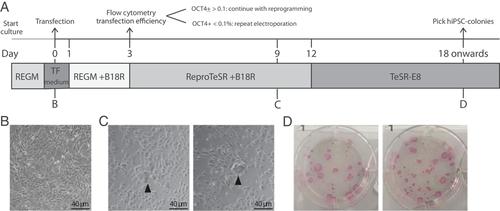Marga J. Bouma, Christiaan H. Arendzen, Christine L. Mummery, Harald Mikkers, Christian Freund
下载PDF
{"title":"Reprogramming Urine-Derived Cells Using Commercially Available Self-Replicative RNA and a Single Electroporation","authors":"Marga J. Bouma, Christiaan H. Arendzen, Christine L. Mummery, Harald Mikkers, Christian Freund","doi":"10.1002/cpsc.124","DOIUrl":null,"url":null,"abstract":"<p>We describe a protocol for efficient generation of human-induced pluripotent stem cells (hiPSCs) from urine-derived cells (UDCs) obtained from adult donors using self-replicative RNA containing the reprogramming factors <i>OCT3/4</i>, <i>SOX2</i>, <i>KLF4</i>, <i>GLIS1</i>, and <i>c-MYC</i> (ReproRNA-OKSGM). After electroporation, transfection efficiency is quantified by measuring OCT3/4-expressing UDCs using flow cytometry and should be ≥0.1%. hiPSC colonies emerge within 3 weeks after transfection and express multiple pluripotency markers. Moreover, the UDC-derived hiPSCs are able to differentiate into cells of all three germ layers and display normal karyotypes. ReproRNA-OKSGM is available commercially and only requires a single transfection step so that the protocol is readily accessible, as well as straightforward. In addition to a detailed step-by-step description for generating clonal hiPSCs from UDCs using ReproRNA-OKSGM, we provide guidance for basic pluripotency characterization of the hiPSC lines. © 2020 The Authors.</p><p><b>Basic Protocol</b>: Reprogramming of urine-derived cells using ReproRNA-OKSGM</p><p><b>Support Protocol 1</b>: Determination of the pluripotency status of hiPSCs by flow cytometry</p><p><b>Support Protocol 2</b>: Characterization of functional pluripotency of hiPSCs</p>","PeriodicalId":53703,"journal":{"name":"Current Protocols in Stem Cell Biology","volume":"55 1","pages":""},"PeriodicalIF":0.0000,"publicationDate":"2020-09-21","publicationTypes":"Journal Article","fieldsOfStudy":null,"isOpenAccess":false,"openAccessPdf":"https://sci-hub-pdf.com/10.1002/cpsc.124","citationCount":"4","resultStr":null,"platform":"Semanticscholar","paperid":null,"PeriodicalName":"Current Protocols in Stem Cell Biology","FirstCategoryId":"1085","ListUrlMain":"https://onlinelibrary.wiley.com/doi/10.1002/cpsc.124","RegionNum":0,"RegionCategory":null,"ArticlePicture":[],"TitleCN":null,"AbstractTextCN":null,"PMCID":null,"EPubDate":"","PubModel":"","JCR":"Q2","JCRName":"Biochemistry, Genetics and Molecular Biology","Score":null,"Total":0}
引用次数: 4
引用
批量引用
Abstract
We describe a protocol for efficient generation of human-induced pluripotent stem cells (hiPSCs) from urine-derived cells (UDCs) obtained from adult donors using self-replicative RNA containing the reprogramming factors OCT3/4 , SOX2 , KLF4 , GLIS1 , and c-MYC (ReproRNA-OKSGM). After electroporation, transfection efficiency is quantified by measuring OCT3/4-expressing UDCs using flow cytometry and should be ≥0.1%. hiPSC colonies emerge within 3 weeks after transfection and express multiple pluripotency markers. Moreover, the UDC-derived hiPSCs are able to differentiate into cells of all three germ layers and display normal karyotypes. ReproRNA-OKSGM is available commercially and only requires a single transfection step so that the protocol is readily accessible, as well as straightforward. In addition to a detailed step-by-step description for generating clonal hiPSCs from UDCs using ReproRNA-OKSGM, we provide guidance for basic pluripotency characterization of the hiPSC lines. © 2020 The Authors.
Basic Protocol : Reprogramming of urine-derived cells using ReproRNA-OKSGM
Support Protocol 1 : Determination of the pluripotency status of hiPSCs by flow cytometry
Support Protocol 2 : Characterization of functional pluripotency of hiPSCs
利用商业上可获得的自我复制RNA和单电穿孔对尿源细胞进行重编程
我们描述了一种利用含有重编程因子OCT3/4、SOX2、KLF4、GLIS1和c-MYC (ReproRNA-OKSGM)的自我复制RNA,从成人供体获得的尿源细胞(UDCs)高效生成人诱导多能干细胞(hiPSCs)的方案。电穿孔后,通过流式细胞术测量表达oct3 /4的UDCs来量化转染效率,转染效率应≥0.1%。hiPSC菌落在转染后3周内出现并表达多种多能性标记物。此外,udc衍生的hiPSCs能够分化为所有三种胚层的细胞,并显示正常的核型。ReproRNA-OKSGM在商业上是可用的,只需要一个转染步骤,因此该方案很容易获得,也很简单。除了使用ReproRNA-OKSGM从UDCs生成克隆hiPSC的详细步骤描述外,我们还提供了hiPSC系基本多能性表征的指导。©2020作者。基本方案:使用reprorna - oksgm对尿源性细胞进行重编程支持方案1:通过流式细胞术确定hipsc的多能性状态支持方案2:hipsc功能多能性的表征
本文章由计算机程序翻译,如有差异,请以英文原文为准。


 求助内容:
求助内容: 应助结果提醒方式:
应助结果提醒方式:


